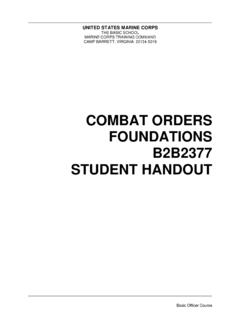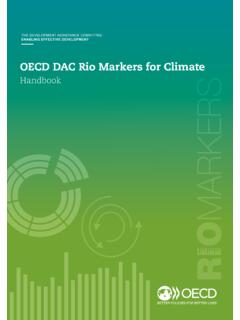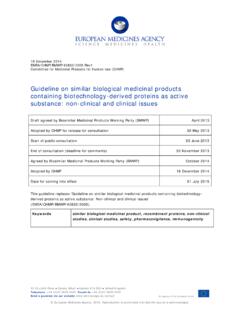Transcription of CHEMICAL, BIOLOGICAL, RADIOLOGICAL, AND NUCLEAR …
1 UNITED STATES MARINE CORPS THE BASIC SCHOOL MARINE CORPS TRAINING COMMAND CAMP BARRETT, VIRGINIA 22134-5019 chemical , biological , radiological , AND NUCLEAR (CBRN) DEFENSE B2I3597 Basic Officer Course B2I3597 CBRN Defense 2 Basic Officer Course CBRN Defense Introduction Ancient Persians were the first to use chemical weapons when they gassed Roman soldiers with toxic fumes 2,000 years ago. Archeologists have found the oldest evidence of chemical warfare yet after studying the bodies of 20 Roman soldiers' found underground in Syria 70 years ago.
2 Dr Simon James, who solved the mystery, said: "The mixture would have produced toxic gases including sulphur dioxide and complex heavy petrochemicals. The victims would have choked, passed out and then died. I believe this is the oldest archaeological evidence of chemical warfare ever found. This is the beginning of a particularly nasty history of killing that continues up to the modern day." Importance You will benefit from this period of instruction by being able to identify CBRN agents, as well as survive a CBRN attack. This lesson covers the following topics: Topic Page Individual Protective Clothing 3 Mission Oriented Protective Posture (MOPP) Analysis 4 chemical Agents: Nerve Agents Blood Blister Choking Agents 5 5 7 8 10 biological Agents 11 Detection Kits 11 Decontamination 13 CBRN Alarms, Signals, and Immediate Action 14 MOPP Gear Exchange 22 Unmasking Procedures 23 CBRN-1 Reports 25 Publications 25 Notes 26 Learning Objectives Terminal Learning Objectives 1.
3 Given a CBRN environment, a field protective mask (SL-3 complete), and CBRN alarm or an order to mask, employ the field protective mask within a time limit of nine seconds of the issuance of the alarm or order. (MCCS-CBRN-1002) 2. Given a unit, a tactical scenario, a training area, and individual protective equipment, employ CBRNE Protective Measures by ensuring complete and serviceable equipment and trained Marines. (MCCS-CBRN-2301) B2I3597 CBRN Defense 3 Basic Officer Course CBRN Defense (Continued) Enabling Learning Objectives 1. Without the aid of references, describe CBRN vocal/visual alarms without error.
4 (MCCS-CBRN-1002a) 2. Without the aid of references, describe the MOPP levels without omission. (MCCS- CBRN-2301a) 3. Without the aid of references, identify NATO CBRN markers without omission. (MCCS-CBRN-2301b) 4. Without the aid of references, describe CBRN detection measures without omission. (MCCS-CBRN-2302a) 5. Given a CBRN casualty and a list of symptoms, identify the type of contamination without error. (MCCS-CBRN-2302b) 6. Given a CBRN casualty, treat the casualty to prevent further injury or death. (MCCS- CBRN-2302c) 7. Given a CBRN environment and individual personal protective equipment, identify the purpose of MOPP gear exchange to minimize CBRN casualties.
5 (MCCS-CBRN- 2302d) 8. Given a CBRN scenario, identify decontamination equipment without omission. (MCCS-CBRN-2302e) 9. Given a CBRN scenario, identify detection equipment without omission. (MCCS- CBRN-2302f) 10. Given a CBRN scenario, describe the purpose of controlling the spread of contamination without omission. (MCCS-CBRN-2302g) 11. Given a CBRN scenario, describe the steps in a CBRN-1 report without omission. (MCCS-CBRN-2302h) Individual Protective Clothing Protective clothing allows units to continue the mission after a chemical or biological attack while limiting the spread of contamination to the individual.
6 Permeable protective clothing allows air and moisture to pass through the fabric. Most personnel use permeable protective clothing such as: Suit, chemical and biological Protective, Carbon Sphere (Saratoga). Joint Service Lightweight Integrated Suit Technology (JSLIST) chemical Protective Ensemble. Four Components of a Protective Ensemble chemical protective suit. Protective mask. chemical Protective overboots. chemical Protective Glove Set. B2I3597 CBRN Defense 4 Basic Officer Course MOPP Analysis Unit Commanders determine the appropriate MOPP level by assessing Mission, Enemy, Time available, Troops and support available, and Terrain and weather (METT- T) factors.
7 This analysis enhances the probability of mission success by balancing the reduced risk of casualties due to chemical / biological agent exposure against the increased risk of performance decrements and heat strain casualties as MOPP levels increase. Flexibility is the key to providing maximum protection with the lowest risk possible, while still allowing mission accomplishment. MOPP analysis provides recommended MOPP levels. METT-T Factors Mission Enemy Time available Troops and support available Terrain and weather What is the mission? What additional protection, such as shelter and cover, is available?
8 How physically and mentally demanding is the work that must be performed? How quickly must the mission be accomplished? What is the expected duration of the mission? Are adequate food and water supplies available? Is an attack probable? Is an attack imminent or in progress? Is the immediate area contaminated once the attack is over? What are the likely targets, threat agents, and warning times? What is the time of day/night for completion of the mission? How much time is available for completion of the mission? Can completion of the mission be delayed? How many personnel are available?
9 What Individual protective equipment do the personnel possess? What is the training status of available personnel? What are the temperature/ humidity? Is it cloudy, sunny, or windy? Is the terrain sandy, mountainous or marshy? Components of the Mission Oriented Protective Posture Levels MOPP Level Components MOPP Ready Protective Mask carried. Permeable protective ensemble available within two hours. Second ensemble will be available in six hours. MOPP ZERO Protective Mask carried. Permeable protective ensemble available within arm s reach. MOPP1 Protective Mask carried.
10 chemical protective trousers and jacket worn. Within arm s reach are: o Overboots o chemical protective gloves. MOPP2 Protective Mask carried. Worn are: o chemical protective trousers and jacket. o Overboots. o chemical protective gloves within arm s reach. MOPP3 Worn are: Protective Mask. chemical protective trousers and jacket with hood. Overboots. chemical protective gloves within arm s reach. B2I3597 CBRN Defense 5 Basic Officer Course MOPP Analysis (Continued) Components of the Mission Oriented Protective Posture Levels (Continued) MOPP4 Worn are: Protective Mask.










